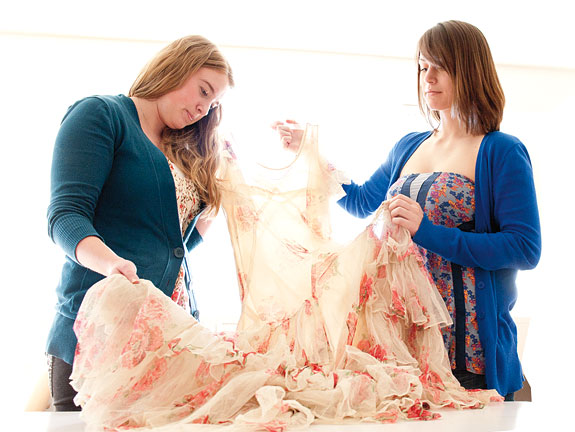Fall fashion week in Pullman featured a stovepipe silhouette and shorter hemline. Black and rhinestones were in, as were gold shoes and feathered cloches.
These weren’t new designs. They were elegant Jazz Age outfits hand-picked by students in a “Costume and Museum Management” class and on display last November in the Terrell Library atrium.

Sophomore Amanda Harris is one of five students who culled through the University’s historic costume collection to decide on a theme and create the 20s in Vogue display. She is one of dozens each year who have the opportunity to dig through an extensive collection of clothing and accessories housed on campus. It was a treat to have a chance to look through the clothes and pull together a cohesive display. “I have always thought I wanted to be a buyer and work behind the scenes and pick out the clothes, but I enjoyed putting up the display so much that it makes me think that maybe I want to go into display work,” she says.
Some of the more interesting pieces in the general collection include garments from missionary Mary Richardson Walker, who in 1839 came west and settled in a mission near the Spokane Indians. There is also a dress that was worn to President Lincoln’s funeral, kimonos, and traditional “bubu” clothing from Africa. The collection holds more than 5,000 garments and accessories, most of which were donated by alumni, professors, community members, foreign exchange students, and the theater department, says Karen Leonas, chair of the Apparel, Merchandising, Design, and Textiles department.
Many of the pieces belonged to residents of Whitman County, including gowns from the Miss Pullman 1958 and 1959 pageants and a dress probably worn by a barmaid or prostitute in the 1800s. Saving garments from the Pullman area not only gives us a picture of the types of clothing and craftsmanship of the past, but gives us insight into the lives of the people who wore them, says Linda Bradley, professor and curator of WSU’s historic costume collection. “I think what’s important is what ordinary everyday people wore,” she adds.
By working with the clothes, the students have the opportunity to gain inspiration, design ideas, and a history lesson through the medium of clothing, says Bradley. Exercises like creating the display last fall provide them a chance to explore the fundamentals of balance, harmony, and repetition.
Several years ago, during the centennial celebration of home economics at WSU, the department put together an exhibit of garments worn at WSU every 10 years, spanning the century. Seeing these pieces on display can be so much more valuable than looking at a piece of fabric, says Bradley. “People really enjoy looking back at fashion in the past because it’s such an immediate and personal thing,” she says. “I like to use it not just to look at history, but [to] look at the social world. What does it tell us about society, life, gender, and all these issues?”
Before deciding on the theme of 20s in Vogue, Harris and her group considered focusing on the Prohibition, evening dresses from the 1920s, and flapper dresses. “We knew we wanted to keep it classy, chic, and go with the black-and-white theme,” says Harris. They settled on two black dresses, shoes, a hat, accessories, and covers of Vogue magazine from the 1920s.
They learned that the ’20s were a significant time in women’s fashion. Just prior to that era, women used corsets to appear feminine, forgoing comfort for style. In the 1920s, their clothes took on more of a “free-falling” style, with less of an emphasis on the curves of women’s bodies, says Harris. The fashion reflected the economic boom as well as women’s greater independence, including winning the right to vote in 1920. Women had a growing presence in the workforce and greater freedom in their communities. That freedom translated to looser clothes with pleats, slits, and significantly rising hemlines. After 1926 (the year of the shortest skirt), the hemlines judiciously dropped back down and, by the Great Depression, women weren’t as risqué in their fashion, nor did they have as many bright and colorful clothes—they couldn’t afford them.
Working with historical clothing—such as the ones in the library display—isn’t the easiest of tasks. The glass and crystal beading on the 1920s garments makes them very heavy. Because of the weight, the dresses can’t be stored on hangers; otherwise the shoulders would begin to rip. When not on display, the clothing is carefully laid flat in archival boxes.
The historical clothing became a formal collection for WSU in the 1940s. Now it is stored in Kruegel Hall where the AMDT department has its home, but is in need of a long-term location, since the department is only in that building temporarily. The department is receiving about 100 more historic and vintage items from the WSU Theatre Department as it is being phased out because of state cuts to the University.
By journeying into the past with the 20s in Vogue exhibit, the students have refined what they want to do in the fashion industry. “The first time we saw it all put together was when we put it up,” says Harris. And with a few last minute edits, they created not only a beautiful scene but a lesson in history.
